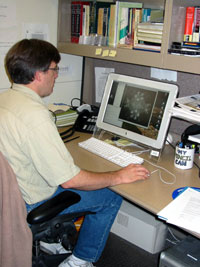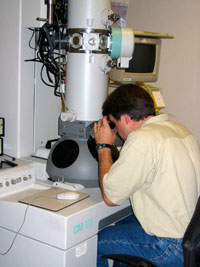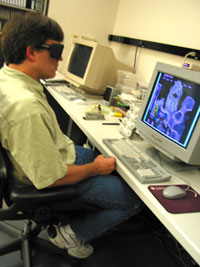 |
 |
|
|
|
1. I chose this career because...
|
Back to Top

|

|
|
David Belnap sits at his desk to work on molecular models.
|
I chose to become a biochemist because I developed a love of science when I was a child. My parents, especially my mother, fostered this interest and instilled in me a love of learning. To this day, my mother's incredible passion for learning is a great example to me. I think it rubbed off! My father was a professor of music and helped instill in me, not only a love of education, but an appreciation for the beauty of the world around us. When I was a child, one of the best things my parents did was to buy a set of encyclopedias. I looked through them often, and developed an interest in many things. For family vacations, my parents took us to national parks and historic sites, instead of amusement parks. This also helped me to love learning and instilled in me a sense of awe and wonder.
In addition to my parent’s influence, I had great teachers. My fourth grade teacher inspired me with stories about his many diving expeditions. My high school biology teacher was another great inspiration who took a personal interest in me. In college, I had motivational teachers in my undergraduate and graduate classes.
Considering my college education, I knew I wanted to do something in science that combined my interests in biology, mathematics, physics, and chemistry. I decided that biochemistry best suited my goal. I have emphasized the more physical and mathematical aspects of biochemistry in my study and research.
Education
- Bachelor of Science, Biochemistry, Brigham Young University, Provo, Utah
- Doctor of Philosophy, Biology, Purdue University, West Lafayette, Indiana
|
|
2. My typical workday involves...
|
Back to Top

|

|
|
David Belnap visualizing multi-dimensional images using an electron microscope.
|
My typical workday starts anywhere from 7:00 to 9:00 a.m. and ends around 5:00 to 6:00 p.m. This flexibility in my work schedule allows me to attend my children's evening activities. Sometimes I work from home or go into the lab on evenings and weekends. While I am at work, I spend most of my time in my office using the computer which is next to my lab.
Major Tasks
- Perform independent experiments and collaborate with other scientists on research projects
- Create 3-Dimensional (3D) Reconstructions - This process, also known as molecular modeling,focuses on determining the 3-dimensional structure of molecules from 2-dimensional images. The images are generated using other laboratory techniques and are visualized with an electron microscope.
My Current Projects
- Poliovirus Project - My collaborators and I are studying how polioviruses enter cells. We are determining the different forms polioviruses take during the cell infection process and modeling the changes that occur in the proteins that make up poliovirus. I am doing the 3-dimensional reconstructions and molecular modeling for this project.
- Hepatitis B Virus Project - My collaborators and I are trying to determine all the sites that antibodies bind to on the capsid (outer shell) of the hepatitis B virus. I am doing the molecular modeling portion of this project.
Additional Roles and Responsibilities
- Computer Operations - I am responsible for computer operations in our lab which includes: ordering computers, computer supplies, and software; fixing bugs that arise in computer programs; supervising people who service our computers and our computer network (system administrators); teaching people how to do 3-dimensional reconstructions, and helping others with computer and image-analyses.
- Mentor/Supervisor -I act as a mentor and supervisor in the lab, and in turn, am mentored by my lab chief.
- Member - I am a member of our institute's information technology committee and the NIH Molecular Modeling Interest Group (MMIG), http://mmignet.nih.gov/.
Equipment Use
- High-performance Computers - They need to be fast and reliable. We usually buy computers that are more expensive than a computer you would usually buy for home.
- Electron Microscope – A microscope that is used to view detailed structures and the composition of molecules of research interest.
- Stereo Glasses – Specialized goggles that allow visualization of 3-dimensional images.
|
|
3. What I like best/least about my work...
|
Back to Top

|

|
|
David Belnap wears special stereo glasses to visualize 3-dimensional images on his computer monitor.
|
What I like best about my work is doing experiments and teaching others how to do experiments. It is a thrill to discover something new. This doesn't happen regularly or often, but it makes all the hard work worthwhile.
What I like least about my work is the administrative paperwork because it takes away time from doing research. Another difficult part of this type of work is that experiments can be difficult. Like every other scientist, I have times when I am frustrated, discouraged, or stumped. But, it is very rewarding when these challenges are eventually overcome.
|
|
4. My career goals are...
|
Back to Top

|
My career goals are to teach and setup my own laboratory. I will actually be leaving the NIH this summer to become a university professor.
|
|
5. When I'm not working, I like to...
|
Back to Top

|
When I’m not working, I like to spend time cycling, hiking, camping, playing music, video recording, nature photography, and participating in sports. I love to spend time with my family doing these things. My wife and I are the parents of five "really cool" children. I enjoy coaching my children and others in sports. I love to read and see good movies and documentaries. I especially like history. I also have an interest in environmental issues, in particular, helping to take better care of the earth and encouraging a sense of wonder and awe about nature.
|
|
6. Making a choice…
|
Back to Top

|
Because I had so many interests when I was growing up, it was difficult for me to decide on a career. When I was a teenager, I wanted to be a wildlife biologist. Eventually I decided to become a biochemist because it allowed me to pursue my love of science as well as my other interests in physics and math.
|
|
|
|
 |